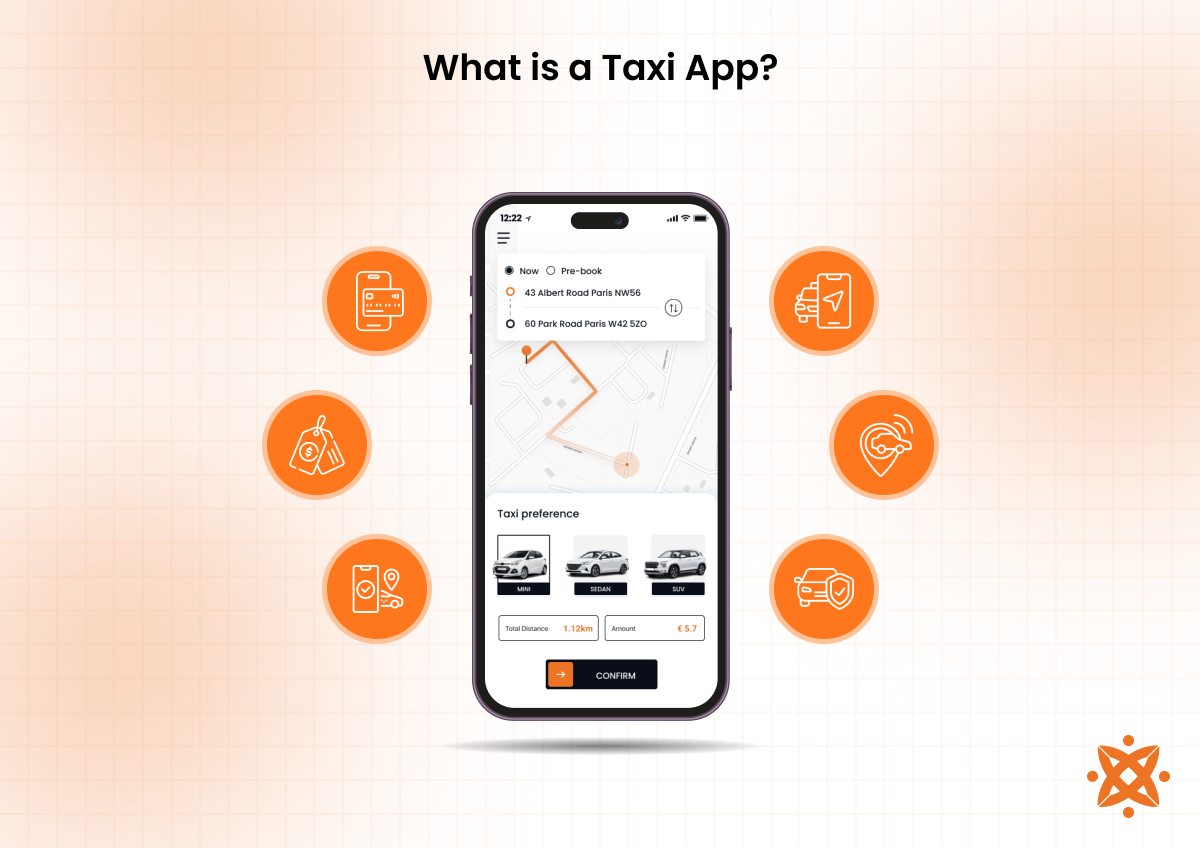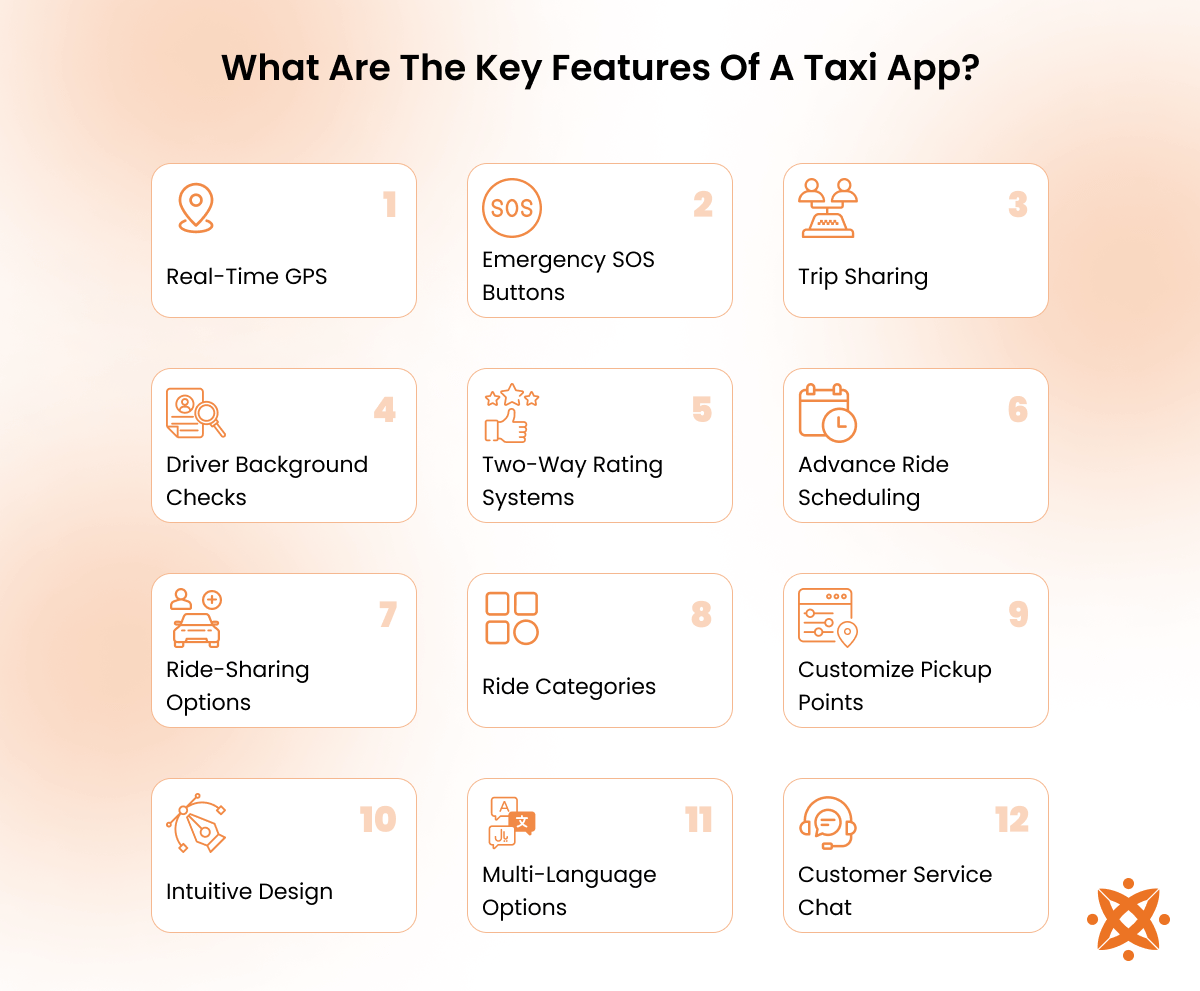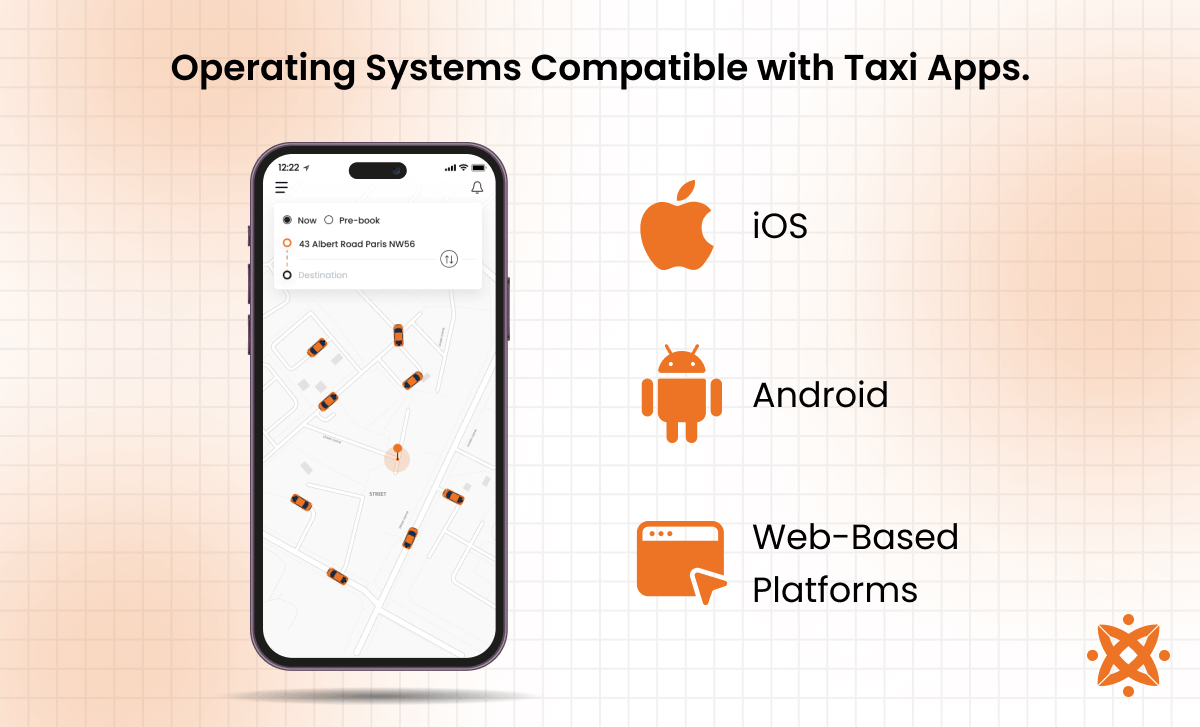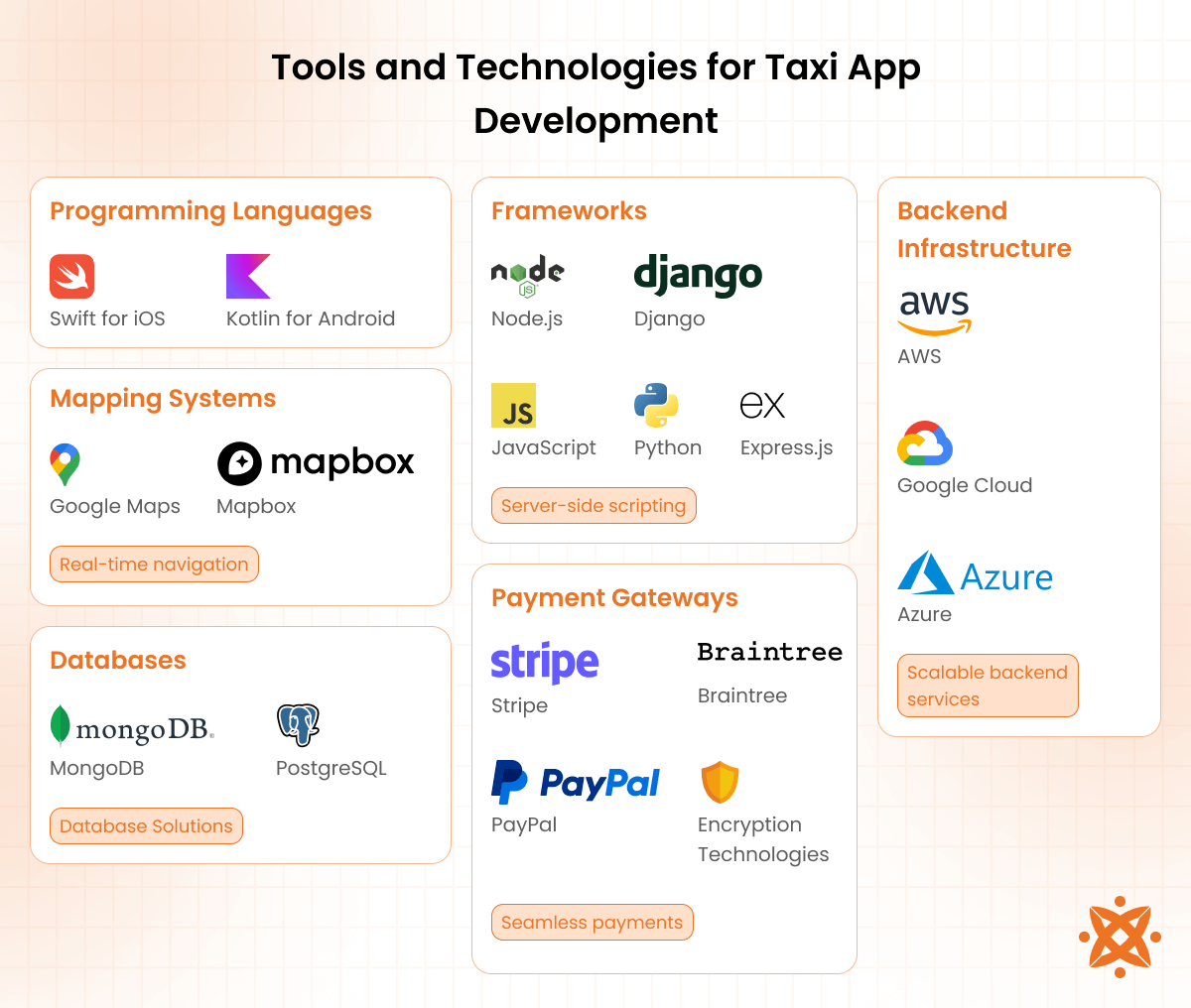
A taxi app refers to a mobile application that connects riders and drivers through real-time GPS tracking and ride-matching algorithms. Its core functionalities include location tracking, fare estimation, and in-app payments for easy booking and payment processes.
The popular types of taxi apps are ride-hailing apps like Uber and Lyft, fleet management apps like Cabify, and other types like ride-sharing apps, which enable users to share rides and reduce costs.
According to Statista (2023), the global ride-hailing market is projected to reach $332 billion by 2028, showing the growing reliance on taxi apps for transportation.
The key features of a taxi app include real-time GPS tracking, ride scheduling, driver and rider profiles, payment integration, and emergency buttons. Features like driver ratings and fare estimation increase transparency, while ride-sharing options add flexibility for users.
Taxi apps are designed for Android, iOS, and web platforms with a responsive design that ensures device adaptability. Cross-platform compatibility is necessary to reach a broader audience and provide a consistent user experience.
A taxi app development process involves conceptualization, design and prototyping, backend and frontend development, and API integration. For example, integrating APIs for real-time GPS tracking and payment gateways ensures functionality and a smooth user experience.
Developing a taxi app costs between £15,000 to £45,000, depending on factors like features and platforms. Backend and frontend development costs take up the bulk of the cost, while design prototyping and API integration contribute the rest.
What is a Taxi App?

A taxi app is a mobile application that connects passengers with available drivers in real-time, providing a simple and efficient means of booking, tracking, and paying for taxi rides.
These apps operate on both Android and iOS platforms, using GPS technology to match passengers with drivers based on proximity.
Taxi apps have changed the way people access transportation services by offering services through digital platforms. The core functionalities of taxi apps include ride booking, GPS-enabled location tracking, and integrated payment systems.
Users book rides instantly or schedule them in advance, monitor their driver’s location and estimated arrival time, and pay through various options, including credit cards, digital wallets, or cash.
Other features of a taxi app include fare estimates, safety measures like driver verification, and in-app customer support. All these improve the overall user experience.
Taxi apps provide advantages over traditional taxi services, such as convenience, reduced waiting times, and cost transparency.
Unlike conventional taxis, which require passengers to locate a cab physically or make phone bookings, taxi apps enable instant bookings at the tap of a screen.
Fare estimates and digital payment options remove squabbles over costs and provide passengers with financial clarity. Safety features, such as driver ratings and trip sharing, also set taxi apps apart.
The impact of taxi apps on the transportation industry has introduced competition to the market. Apps like Uber and Bolt have lowered fares and improved service quality.
According to a study by the MIT Urban Mobility Lab (2020), taxi apps have increased vehicle utilization rates by 65%, significantly reducing idle time for drivers. They have also improved accessibility for passengers in remote areas where traditional taxi availability is limited.
What Are the Types of Taxi Apps?

The different types of taxi apps are categorized based on their operational models and geographic focus, such as Uber, Lyft, and Bolt, which provide on-demand ride-hailing services, and apps like Cabify, Grab, and Careem, which offer region-specific features special to local markets.
These taxi apps have dominated the taxi transportation markets, allowing users to negotiate fares directly.
The types of taxi apps include:
- On-Demand Ride-Hailing Apps: Apps like Uber, Lyft, and Bolt allow users to book rides instantly through a mobile interface. They use real-time GPS tracking to match passengers with nearby drivers and provide transparent pricing.
- Regional Ride-Hailing Apps: Platforms like Grab (Southeast Asia), Cabify (Latin America and Spain), and Careem (Middle East) focus on region-specific features such as multilingual interfaces, cash payment options, or service customization for local markets.
- Traditional Taxi Integration Apps: Apps like Curb and Gett connect users to licensed taxi drivers, enabling traditional taxi services to operate digitally. These apps include fixed fares and the ability to pre-book rides.
- Negotiable Fare Apps: Platforms like inDrive and Heetch offer a unique approach where passengers and drivers negotiate fares directly, giving users more control over costs while increasing flexibility.
- Emerging Market Apps: Apps such as Ola Cabs (India) and Easy Taxi (Latin America) cater to growing markets by solving local needs, including affordable pricing and simplified user interfaces to reach a broader audience.
What Are The Key Features Of A Taxi App?

The key features of taxi apps are real-time GPS, emergency SOS buttons, trip sharing, driver background checks, two-way rating systems, advanced ride scheduling, ride-sharing options, ride categories, the ability to customize pickup points, intuitive design, multi-language options, and a customer service chat for support.
These features make the taxi app more enjoyable and easier to use than the traditional taxi service.
The key features of a taxi app include:
- Real-Time GPS: This feature allows passengers to track the driver’s location and estimated arrival time in real-time. It also enables drivers to find better routes for quicker travel. Real-time GPS increases safety and convenience by ensuring both parties are aware of the trip’s progress.
- In-App Payment System: Taxi apps integrate multiple payment options, including credit cards, digital wallets, and cash. This removes the need for physical payments and improves transaction security. Users also receive digital receipts for easy expense tracking.
- Emergency SOS Buttons: An SOS button provides immediate assistance in emergencies by alerting local authorities or designated contacts. It is a necessary safety feature that ensures help is sent quickly. Some apps also share real-time locations during emergencies.
- Trip Sharing: This feature allows users to share their trip details and live location with family or friends. It provides peace of mind for passengers traveling alone. Trip sharing is easily accessible within the app, making safety a priority.
- Driver Background Checks: Taxi apps conduct thorough background checks on drivers to ensure passenger safety. These checks include verifying criminal records, driving history, and identification. Regular updates maintain the credibility of the driver network.
- Two-Way Rating Systems: Both passengers and drivers rate each other after a trip. This offers accountability and helps maintain service quality. Poor ratings result in corrective measures or removal from the platform.
- Advance Ride Scheduling: Users schedule rides for future dates and times through this feature. It is ideal for ensuring timely pickups for early flights, meetings, or events. Advance scheduling guarantees availability and removes last-minute stress.
- Ride-Sharing Options: Taxi apps include shared ride features that allow multiple passengers to split the cost of a trip. This reduces fares and minimizes environmental impact. Ride-sharing also increases the availability of services in high-demand areas.
- Ride Categories: Apps offer different ride options, such as economy, luxury, or SUVs, to cater to diverse needs and budgets. This flexibility allows passengers to select a service level that matches their preferences. Premium categories include additional amenities like Wi-Fi.
- Customize Pickup Points: Users adjust their pickup location within the app, even if it differs from their current GPS location. This is useful in areas with limited access or complex addresses. The feature adds convenience and ensures smooth pickups.
- Intuitive Design: A user-friendly interface increases smooth navigation through the app, from booking a ride to making payments. Intuitive designs prioritize simplicity and reduce the learning curve for new users. Clean layouts and accessible icons enhance the overall experience.
- Multi-Language Options: Apps support multiple languages to accommodate diverse user bases in global markets. This feature ensures that passengers can access services in their preferred language. It also increases inclusivity and usability across regions.
- Customer Service Chat: An integrated chat system allows users to resolve issues directly within the app. It provides instant responses to queries about bookings, payments, or lost items. Customer support ensures a reliable and stress-free experience for users.
What Operating Systems Is A Taxi App Compatible With?

A taxi app is compatible with iOS, Android, and web-based platforms, ensuring accessibility for a wide range of users.
These apps are available for download on the Apple App Store for iOS devices and the Google Play Store for Android devices, covering the majority of smartphone users globally.
Compatibility with cross-platform frameworks ensures a smooth user experience across different devices and operating systems.
Taxi apps designed for iOS require a minimum version of iOS, ensuring they leverage the latest features of Apple devices. Apps on the Apple App Store undergo strict quality control, making them reliable and user-friendly for iPhone and iPad users.
Android systems are also widely used due to their availability on both high-end and low-end devices, making taxi apps accessible to a broader audience.
The Google Play Store supports frequent updates, allowing apps to remain compatible with a diverse range of Android versions. Android’s flexibility ensures that users with older or budget-friendly devices also utilize taxi apps.
Web-based platforms also extend the reach of taxi apps to users without smartphones. These platforms allow bookings directly from browsers.
Taxi apps cater to a wide range of users, increasing accessibility by integrating compatibility with minimum iOS and Android versions on low-end devices.
How To Develop A Taxi App Like Uber?
Developing an uber taxi app involves market research, app design, and advanced technology integration.
The process begins with identifying target users and their specific needs, followed by designing an intuitive interface with features like real-time GPS, in-app payments, and ride-sharing options.
Finally, leveraging backend technologies and APIs ensures operations, scalability, and a reliable user experience.
What Tools and Technologies are Used in Taxi App Development?

Tools and technologies used in taxi development include programming languages, frameworks, navigation, payment gateways, and backend services.
These technologies ensure secure, scalable, and user-friendly applications, employing multiple tools for their services.
The tools and technologies used in taxi app development are:
Programming Languages and Frameworks
Taxi app development utilizes specialized programming languages and frameworks for creating responsive and scalable applications. Programming language and framework tools include:
- Swift for iOS: Swift is the preferred language for iOS app development due to its speed, safety features, and easy integration with Apple’s ecosystem.
- Kotlin for Android: Kotlin is widely used for Android apps because of its concise syntax, interoperability with Java, and strong performance.
- JavaScript or Python for Backend Development: JavaScript and Python are popular backend programming languages offering flexibility and extensive libraries for building robust server-side applications.
- Node.js: Node.js is a JavaScript runtime environment known for handling high-traffic applications and real-time data exchanges efficiently.
- Django: Django is a Python-based framework that ensures rapid development and secure web application design.
- Express.js: Express.js is a minimalist Node.js framework ideal for building scalable backend systems.
Mapping and Navigation Technologies
Mapping technologies are necessary for route optimization and real-time tracking. Mapping and navigation technology tools for taxi app development include:
- Google Maps API: Google Maps API provides precise location tracking, turn-by-turn navigation, and integration with local mapping data.
- Mapbox: Mapbox is an alternative mapping tool offering customizable maps, advanced geolocation features, and dynamic routing options.
Payment Gateways and Security Tools
Integrating secure and reliable payment gateways is relevant for easy transactions in taxi apps.
- Stripe: Stripe supports multiple payment methods, including credit cards and digital wallets, while ensuring secure encryption of sensitive data.
- PayPal: PayPal provides a widely recognized and user-friendly payment system that detects fraud and protects buyers.
- Braintree: Braintree, a subsidiary of PayPal, offers customizable payment solutions and supports global transactions.
- Encryption Technologies: Encryption tools ensure secure data exchange, protecting user information such as payment details and personal data.
Backend Infrastructure and Database Solutions
Reliable backend infrastructure and database solutions enable the app to handle high user loads and ensure data integrity. The backend infrastructure and database solutions for taxi app development include:
- Cloud Platforms (AWS, Google Cloud, or Microsoft Azure): These platforms provide scalable server resources, storage, and tools for managing backend operations efficiently.
- Databases (MongoDB or PostgreSQL): MongoDB, a NoSQL database, is suitable for apps requiring high-speed data storage, while PostgreSQL is a robust relational database ideal for complex queries and transactions.
What Is The Cost Of Developing A Taxi App?
The cost of developing a taxi app is between £12,000 and £40,000, depending on various factors such as features, platform compatibility, and development complexity.
The app development cost varies significantly based on specific requirements and the geographic location of the development team.
The scope and complexity of the app features are the most significant cost factors, ranging from £8,000 to £30,000.
Basic features like ride booking and real-time GPS are less costly, while advanced functionalities such as trip sharing, multi-language support, and in-app analytics increase the overall cost.
Platform compatibility, whether developing for Android, iOS, or both, adds £5,000 to £7,000 to the total cost.
Building cross-platform apps or adding web-based compatibility also increases expenses due to additional testing and optimization.
The design and user interface (UI/UX) contribute £3,000 to £6,000 to the development cost. An intuitive design with user-friendly navigation and visually appealing elements ensures a smooth experience but requires skilled designers and iterative testing.
The backend infrastructure cost, including cloud hosting and database solutions, is between £4,000 to £8,000.
Cloud platforms like AWS or Google Cloud and robust databases like MongoDB or PostgreSQL are necessary for handling large-scale operations securely.
Finally, developer location plays a role, as hourly rates vary widely. Hiring a team in North America may cost $100 to $200 per hour, whereas developers in Eastern Europe or Asia charge between $30 to $70 per hour, directly impacting the overall budget.
What Are The Best Taxi App Builders?
The best taxi app builders include platforms like Appy Pie, BuildFire, and Andromo, which enable users to create taxi apps with minimal coding knowledge.
According to TechRadar (2023), Appy Pie provides robust features such as real-time GPS integration and payment gateways, making it a popular choice for beginners and small businesses.
Similarly, BuildFire offers extensive customization options and scalability for professional-grade apps, while Andromo focuses on cost-effective solutions for Android platforms. These platforms simplify app development, making them ideal for those seeking affordable and efficient taxi app creation.
Can You Design A Taxi App With Ai?
Yes, you can design a taxi app using AI technologies to improve functionality and user experience. These AI technology features include dynamic pricing models, predictive route optimization, and driver-matching algorithms.
Integrating AI into app design reduces ride wait while enhancing route accuracy. AI-powered chatbots and voice assistants also make customer service an easy and simpler interactive experience.
What Are The Design Requirements For A Taxi App?
The design requirements for a taxi app include intuitive user interfaces, robust functionality, and a slick user experience across devices. A clean, visually appealing layout ensures ease of navigation for both passengers and drivers.
Features such as real-time GPS tracking, customizable pickup points, and ride category selection should be prominently displayed and easy to access.
The app must integrate multi-language support and accessibility options to cater to diverse user bases.
A taxi app development company must include secure in-app payment systems, two-way rating mechanisms, and emergency SOS buttons to enhance functionality, safety, and trust.
A responsive design ensures compatibility with multiple platforms, including Android, iOS, and web-based systems, while maintaining performance on both high-end and low-end devices.
How To Choose An App Development Agency In The UK?
To choose a taxi app development agency in the UK, consider experience, technical expertise, and portfolio quality.
Look for agencies with a proven track record of delivering apps similar to your requirements, focusing on user-friendly designs and scalable architectures.
Evaluate their expertise in technologies like AI integration, real-time GPS tracking, and secure payment systems, ensuring they meet your specific needs.
Also, consider their client reviews, pricing structure, and post-launch support services. Agencies offering transparent communication, agile development practices, and long-term maintenance are ideal.
What Are The Best Taxi Apps In The UK?
The best taxi apps in the UK include Uber, Bolt, Free Now, Gett, and Wheely. These platforms offer different services, such as ride-hailing, eco-friendly rides, and luxury transport, catering to various passenger preferences.
Uber dominates the market with widespread availability and multiple ride options despite historical licensing challenges. Bolt, a key competitor, focuses on affordability and sustainability by offering services like electric vehicle rides.
Free Now, formed from the merger of MyTaxe and Hailo, serves cities such as London and Edinburgh, offering black taxis and private hire vehicles.
Gett caters primarily to corporate clients with carbon-neutral initiatives and access to electric taxis. Meanwhile, Wheely provides a premium experience featuring professional chauffeurs and luxury vehicles for upscale travel.
These apps have increased transportation options across the UK, making travel more efficient, accessible, and adapted to individual needs.
Never Miss an Update From Us!
Sign up now and get notified when we publish a new article!
Dhaval Sarvaiya
Co-Founder
Hey there. I am Dhaval Sarvaiya, one of the Founders of Intelivita. Intelivita is a mobile app development company that helps companies achieve the goal of Digital Transformation. I help Enterprises and Startups overcome their Digital Transformation and mobile app development challenges with the might of on-demand solutions powered by cutting-edge technology.
